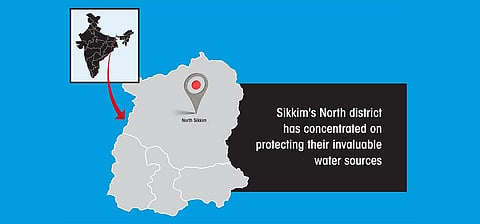

This was first published in Big change is possible: Best practices in water supply and sanitation in India
North district in Sikkim depends on springs for its drinking water supply. Communities are forced to fetch water from far-off sources, trudging across the hilly terrain.
The menfolk work mainly as labourers in tourist centres of the state; getting clean and sufficient drinking water was largely the work of the women.
North Sikkim has enough springs for the communities in the district, but the challenge has been to traverse the steep cliffs every day to fetch water. Women in the district walked for one to three kilometre per day, and the difficult terrain meant that this took close to four hours.
The National Rural Drinking Water Programme was launched in Sikkim in 2009 to ensure safe and regular water supply. The programme suffered due to political will, lack of coordination between the state and Centre, non-involvement of communities in planning projects, and non-functioning or non-existent state-level agencies for the execution of the programme.
By 2017, only 18 per cent of the total households were provided tap connections of which not all were provided with functional taps. The communities hence still had to walk several kilometres to fetch water.
In 2019, Jal Jeevan Mission was launched in the country by the Department of Drinking Water and Sanitation under the Ministry of Jal Shakti. Facililated by the Mission, around 90 per cent of the households in the district now have functional household tap connections.
North District was the first district in the state to implement the Mission as a pilot. Springs were identified even in remote areas and water collection structures such as small tanks and conveyance structures such as open channels were made around them to collect, store and distribute water to all households.
The district was divided into wards to make supply easier in a difficult terrain. Data related to service delivery was collected strictly for the purpose of monitoring on the basis of wards.
Nearly 800 families benefited by the work under Jal Jeevan Mission. On average, around 15-20 families benefit from one source, depending upon its discharge. For example, if a source discharges 0.5-0.8 litre per second, it can cater to about 16 families. If the discharge is more, around 20 families can be catered to.
The source must be well protected from any kind of encroachment or human activity. The local belief is that springs become polluted if humans touch them, and hence the source is kept clean.
Since the district receives around 2,500 mm of rainfall annually and the source of the springs are mostly Himalayan glaciers, the sustainability of springs has not been a problem in this district.
During the monsoon, the spring water may become turbid as the rain feeding the springs may carry mud along with it. The water collected from the source is conveyed to a collecting tank of capacity of up to 2,000 litres and conveyed to a sedimentation chamber, a three-chambered tank where the sediments settle at the bottom.
The clear water is then collected in a distribution tank of capacity 4,000–10,000 litre and the water is distributed to households. The communities are aware enough to not waste the water.
Sikkim has received 100 per cent funding from the Department of Rural Drinking Water and Sanitation under the Ministry of Jal Shakti to provide functional household taps. The Department of Rural Development has implemented the programme in the state.
Village Water and Sanitation Committees (VWSCs) have been formed in all villages that look after operation of installed pipelines and retrofitted works under the mission.
The committees comprise elderly people, women and youth who take active part in meetings and make decisions regarding overall operations and maintenance of the water supply system.
A nominal amount of Rs 50 is collected as service charge from every beneficiary household and deposited in the VWSC's account to be utilised for maintenance of the system.
Technical support for the operation and maintenance of the water supply systems is provided by the Rural Development Department. Every VWSC has a barefoot engineer—a VWSC member—who keeps a log of the repair needs of the system.